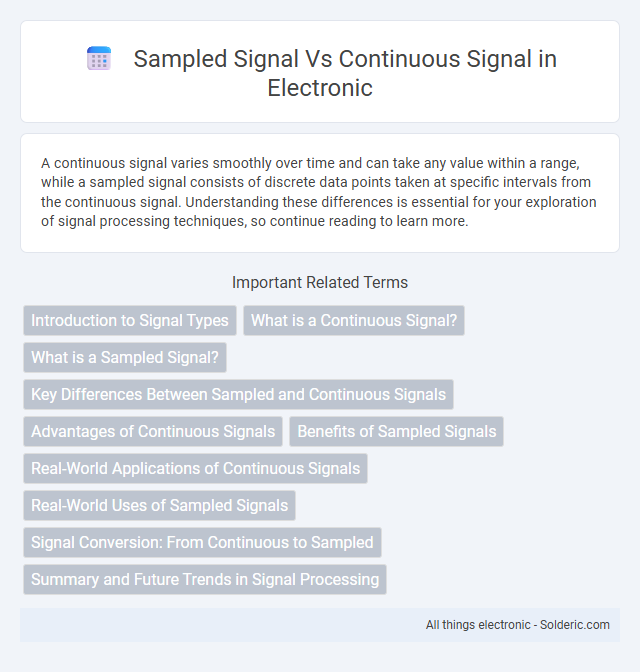A continuous signal varies smoothly over time and can take any value within a range, while a sampled signal consists of discrete data points taken at specific intervals from the continuous signal. Understanding these differences is essential for your exploration of signal processing techniques, so continue reading to learn more.
Comparison Table
| Aspect | Sampled Signal | Continuous Signal |
|---|---|---|
| Definition | Discrete values taken at specific time intervals | Values defined for every instant of time |
| Time Domain | Discrete-time | Continuous-time |
| Amplitude | Can be discrete or continuous | Usually continuous |
| Representation | Sequence of samples | Continuous waveform |
| Data Size | Finite and countable | Infinite and uncountable |
| Processing | Digital signal processing (DSP) | Analog signal processing |
| Storage | Easier and efficient in digital form | Requires special analog storage |
| Examples | Digital audio, sampled ECG | Analog audio, natural sound waves |
Introduction to Signal Types
Sampled signals represent discrete data points obtained by measuring a continuous signal at specific intervals, preserving essential information for digital processing. Continuous signals vary smoothly over time, delivering an uninterrupted range of amplitude values crucial for analog systems. Understanding the distinction between sampled and continuous signals is fundamental in digital signal processing, telecommunications, and control systems.
What is a Continuous Signal?
A continuous signal is a type of signal characterized by its uninterrupted and infinite range of values over time, often represented mathematically as a continuous function. Unlike sampled signals, which capture discrete data points at specific intervals, continuous signals provide detailed, real-time information essential for analog systems such as audio and temperature measurements. These signals enable precise representation and analysis of physical phenomena in domains like electronics and telecommunications.
What is a Sampled Signal?
A sampled signal is a discrete representation of a continuous signal obtained by measuring its amplitude at uniform intervals, known as the sampling rate or frequency. This process converts analog signals into digital form, enabling efficient storage, processing, and transmission in digital systems. Your choice of sampling rate directly impacts the accuracy and quality of the sampled signal, governed by the Nyquist-Shannon sampling theorem.
Key Differences Between Sampled and Continuous Signals
Sampled signals consist of discrete data points obtained at specific time intervals, whereas continuous signals represent information in an unbroken, continuous time domain. The key differences include the digital nature of sampled signals, which enables processing with digital systems, compared to continuous signals that require analog handling. Sampling converts continuous signals into a sequence of values, facilitating storage, transmission, and analysis in digital form, while continuous signals provide infinite resolution and smooth representation of information.
Advantages of Continuous Signals
Continuous signals offer superior resolution and accuracy, capturing an unbroken range of values that enable precise representation of real-world phenomena. Their seamless nature allows for easier analysis of frequency components and instantaneous changes, which is crucial in applications like audio processing and analog communication. Your systems benefit from higher fidelity and smoother signal transitions, enhancing performance in critical monitoring and control environments.
Benefits of Sampled Signals
Sampled signals enable efficient digital storage and processing, allowing precise manipulation and analysis using computer algorithms. You gain improved noise immunity and easier transmission over digital communication systems compared to continuous signals. This ensures greater flexibility in applications like audio processing, telecommunications, and control systems.
Real-World Applications of Continuous Signals
Continuous signals play a crucial role in real-world applications such as audio transmission, analog communication systems, and biomedical monitoring where precise, uninterrupted data representation is essential. Your hearing aids, for example, rely on continuous signals to capture natural sound waves, enabling accurate amplification and clarity. Unlike sampled signals, continuous signals provide seamless data flow critical for high-fidelity sound reproduction and real-time physiological measurements.
Real-World Uses of Sampled Signals
Sampled signals are crucial in digital communications, allowing audio, video, and sensor data to be converted into discrete values for efficient processing and storage. Your smartphone captures sound and images through sampled signals, enabling high-quality playback and transmission over networks. In medical devices like ECG monitors, sampled signals provide precise digital representations of continuous physiological data for accurate diagnosis and monitoring.
Signal Conversion: From Continuous to Sampled
Signal conversion from continuous to sampled involves capturing discrete values of a continuous signal at specific time intervals, known as sampling rates, which must comply with the Nyquist theorem to prevent aliasing. Your choice of sampling frequency directly affects signal accuracy and resolution, ensuring the digital representation maintains the integrity of the original analog input. Proper quantization and encoding further optimize the conversion process for reliable digital signal processing and analysis.
Summary and Future Trends in Signal Processing
Sampled signals convert continuous signals into discrete data points, enabling digital signal processing with precise analysis and manipulation, while continuous signals represent real-world phenomena without interruption. Advances in machine learning and AI-driven algorithms are enhancing the accuracy and efficiency of processing both sampled and continuous signals. Your applications will benefit from emerging trends like hybrid signal processing frameworks and real-time adaptive filtering technologies, driving innovation in communications, healthcare, and IoT systems.
sampled signal vs continuous signal Infographic

 solderic.com
solderic.com